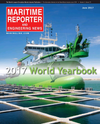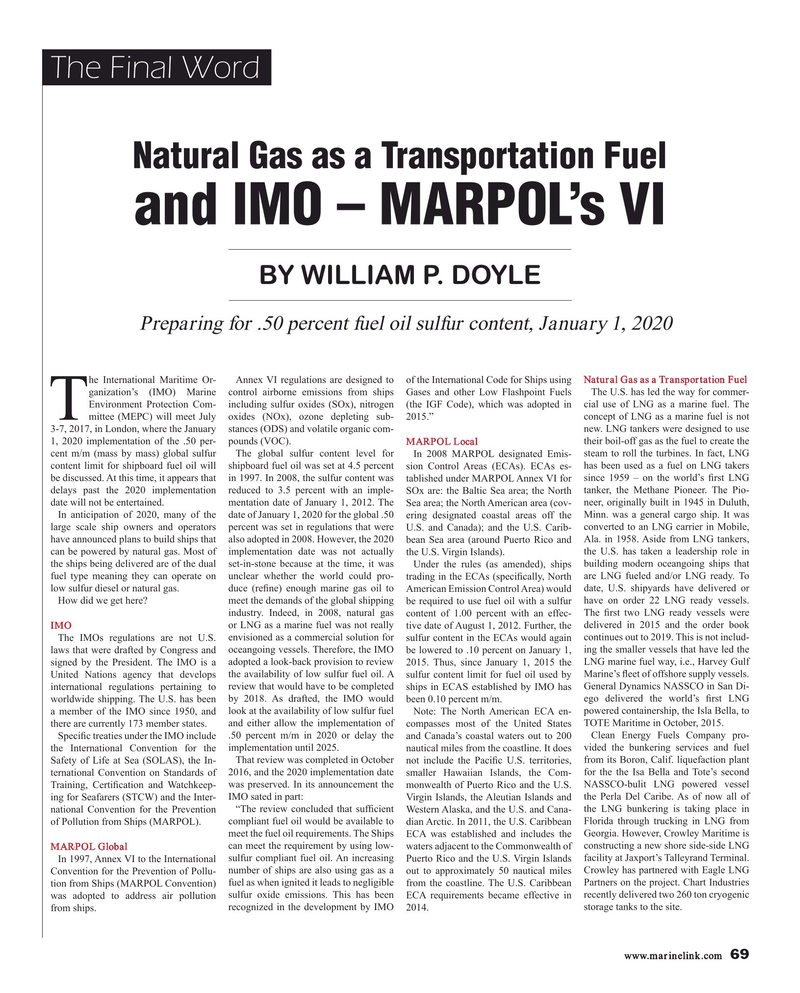
Page 69: of Maritime Reporter Magazine (June 2017)
U.S. Navy Quarterly
Read this page in Pdf, Flash or Html5 edition of June 2017 Maritime Reporter Magazine
The Final Word
Natural Gas as a Transportation Fuel and IMO – MARPOL’s VI
BY WILLIAM P. DOYLE
Preparing for .50 percent fuel oil sulfur content, January 1, 2020 he International Maritime Or- Annex VI regulations are designed to of the International Code for Ships using Natural Gas as a Transportation Fuel ganization’s (IMO) Marine control airborne emissions from ships Gases and other Low Flashpoint Fuels The U.S. has led the way for commer-
Environment Protection Com- including sulfur oxides (SOx), nitrogen (the IGF Code), which was adopted in cial use of LNG as a marine fuel. The
Tmittee (MEPC) will meet July oxides (NOx), ozone depleting sub- 2015.” concept of LNG as a marine fuel is not 3-7, 2017, in London, where the January stances (ODS) and volatile organic com- new. LNG tankers were designed to use 1, 2020 implementation of the .50 per- pounds (VOC). MARPOL Local their boil-off gas as the fuel to create the cent m/m (mass by mass) global sulfur The global sulfur content level for In 2008 MARPOL designated Emis- steam to roll the turbines. In fact, LNG content limit for shipboard fuel oil will shipboard fuel oil was set at 4.5 percent sion Control Areas (ECAs). ECAs es- has been used as a fuel on LNG takers be discussed. At this time, it appears that in 1997. In 2008, the sulfur content was tablished under MARPOL Annex VI for since 1959 – on the world’s ? rst LNG delays past the 2020 implementation reduced to 3.5 percent with an imple- SOx are: the Baltic Sea area; the North tanker, the Methane Pioneer. The Pio- date will not be entertained. mentation date of January 1, 2012. The Sea area; the North American area (cov- neer, originally built in 1945 in Duluth,
In anticipation of 2020, many of the date of January 1, 2020 for the global .50 ering designated coastal areas off the Minn. was a general cargo ship. It was large scale ship owners and operators percent was set in regulations that were U.S. and Canada); and the U.S. Carib- converted to an LNG carrier in Mobile, have announced plans to build ships that also adopted in 2008. However, the 2020 bean Sea area (around Puerto Rico and Ala. in 1958. Aside from LNG tankers, can be powered by natural gas. Most of implementation date was not actually the U.S. Virgin Islands). the U.S. has taken a leadership role in the ships being delivered are of the dual set-in-stone because at the time, it was Under the rules (as amended), ships building modern oceangoing ships that fuel type meaning they can operate on unclear whether the world could pro- trading in the ECAs (speci? cally, North are LNG fueled and/or LNG ready. To low sulfur diesel or natural gas. duce (re? ne) enough marine gas oil to American Emission Control Area) would date, U.S. shipyards have delivered or
How did we get here? meet the demands of the global shipping be required to use fuel oil with a sulfur have on order 22 LNG ready vessels. industry. Indeed, in 2008, natural gas content of 1.00 percent with an effec- The ? rst two LNG ready vessels were
IMO or LNG as a marine fuel was not really tive date of August 1, 2012. Further, the delivered in 2015 and the order book
The IMOs regulations are not U.S. envisioned as a commercial solution for sulfur content in the ECAs would again continues out to 2019. This is not includ- laws that were drafted by Congress and oceangoing vessels. Therefore, the IMO be lowered to .10 percent on January 1, ing the smaller vessels that have led the signed by the President. The IMO is a adopted a look-back provision to review 2015. Thus, since January 1, 2015 the LNG marine fuel way, i.e., Harvey Gulf
United Nations agency that develops the availability of low sulfur fuel oil. A sulfur content limit for fuel oil used by Marine’s ? eet of offshore supply vessels. international regulations pertaining to review that would have to be completed ships in ECAS established by IMO has General Dynamics NASSCO in San Di- worldwide shipping. The U.S. has been by 2018. As drafted, the IMO would been 0.10 percent m/m. ego delivered the world’s ? rst LNG a member of the IMO since 1950, and look at the availability of low sulfur fuel Note: The North American ECA en- powered containership, the Isla Bella, to there are currently 173 member states. and either allow the implementation of compasses most of the United States TOTE Maritime in October, 2015.
Speci? c treaties under the IMO include .50 percent m/m in 2020 or delay the and Canada’s coastal waters out to 200 Clean Energy Fuels Company pro- the International Convention for the implementation until 2025. nautical miles from the coastline. It does vided the bunkering services and fuel
Safety of Life at Sea (SOLAS), the In- That review was completed in October not include the Paci? c U.S. territories, from its Boron, Calif. liquefaction plant ternational Convention on Standards of 2016, and the 2020 implementation date smaller Hawaiian Islands, the Com- for the the Isa Bella and Tote’s second
Training, Certi? cation and Watchkeep- was preserved. In its announcement the monwealth of Puerto Rico and the U.S. NASSCO-bulit LNG powered vessel ing for Seafarers (STCW) and the Inter- IMO sated in part: Virgin Islands, the Aleutian Islands and the Perla Del Caribe. As of now all of national Convention for the Prevention “The review concluded that suf? cient Western Alaska, and the U.S. and Cana- the LNG bunkering is taking place in of Pollution from Ships (MARPOL). compliant fuel oil would be available to dian Arctic. In 2011, the U.S. Caribbean Florida through trucking in LNG from meet the fuel oil requirements. The Ships ECA was established and includes the Georgia. However, Crowley Maritime is
MARPOL Global can meet the requirement by using low- waters adjacent to the Commonwealth of constructing a new shore side-side LNG
In 1997, Annex VI to the International sulfur compliant fuel oil. An increasing Puerto Rico and the U.S. Virgin Islands facility at Jaxport’s Talleyrand Terminal. number of ships are also using gas as a out to approximately 50 nautical miles Crowley has partnered with Eagle LNG
Convention for the Prevention of Pollu- tion from Ships (MARPOL Convention) fuel as when ignited it leads to negligible from the coastline. The U.S. Caribbean Partners on the project. Chart Industries was adopted to address air pollution sulfur oxide emissions. This has been ECA requirements became effective in recently delivered two 260 ton cryogenic from ships. recognized in the development by IMO 2014. storage tanks to the site. www.marinelink.com 69
MR #6 (66-73).indd 69 MR #6 (66-73).indd 69 6/9/2017 12:04:47 PM6/9/2017 12:04:47 PM

 68
68

 70
70
